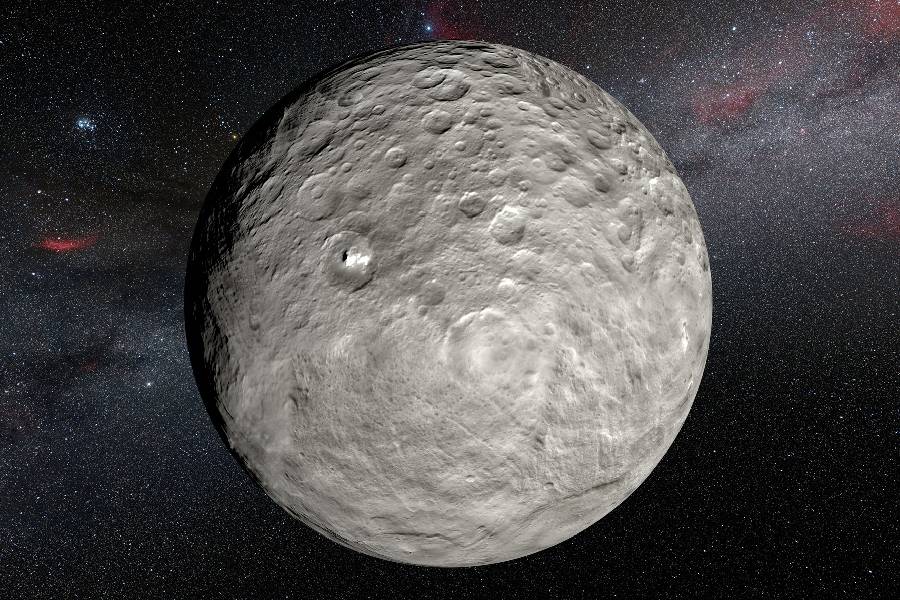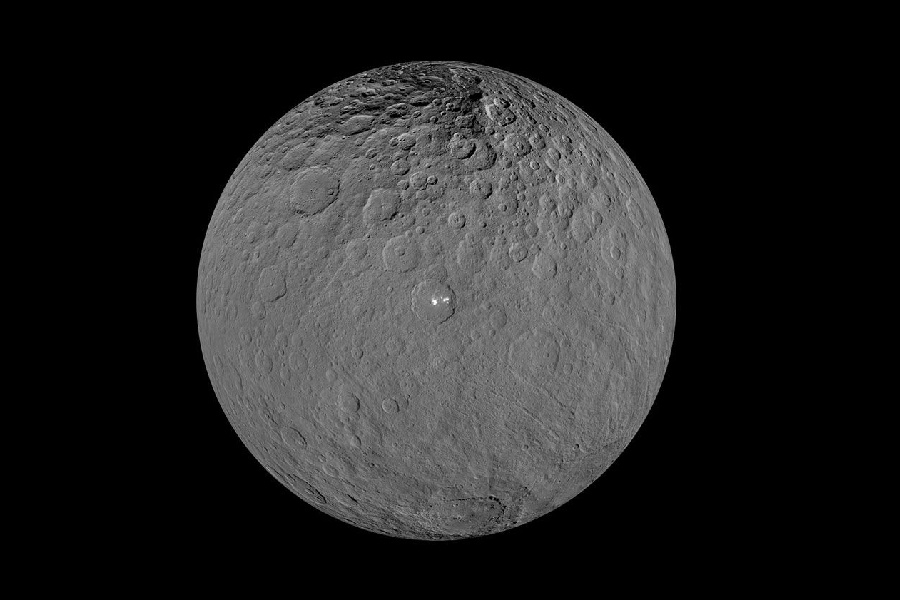Ceres is the largest object in the asteroid belt between the orbits of Mars and Jupiter. Discovered in 1801, it was originally classified as a planet. But is Ceres a planet now?
The debate over Ceres’ classification has reignited with the definition of ‘dwarf planet’ adopted in 2006. From its orbital path to the possibility of subsurface oceans, we’ll delve into the factors central to the argument for or against Ceres’ planethood.
With a curious landscape of craters and bright spots, we will finally decide whether Ceres has more in common with its smaller asteroid neighbors or the majestic planets of our solar system.
Is Ceres a Planet?
Unfortunately, no, Ceres is not a planet. While Ceres orbits the Sun like a planet, it did not meet the IAU’s definition of a planet when it was established. Based on its size and location, it is considered a dwarf planet today, just like Pluto.
When Ceres was discovered in 1801, it was classified as a planet, but later, in 2006, Ceres was reclassified again by the International Astronomical Union as a dwarf planet.
To be classified as a full planet, an object must clear its orbit of other objects. Ceres has not cleared its orbit of other asteroids.

Characteristics of Ceres
Physical properties
Size and mass
With a diameter of about 590 miles (950 km), Ceres is by far the largest object in the asteroid belt. It comprises almost a third of the mass of the entire belt, giving it substantial gravitational influence relative to other asteroids.
Composition
Ceres have an icy, rocky composition, consisting predominantly of water, ice, and carbonates, with smaller amounts of rock and other minerals.
This differentiates Ceres from terrestrial planets like Earth and Mars, which have metallic cores and pure rocky asteroids composed solely of silicates. The significant water content has fueled speculation about a possible subsurface ocean.
Orbital characteristics
Orbit
Ceres follows an elliptical orbit around the Sun, ranging from 2.55 to 2.98 AU over its 4.6 Earth-year orbital period. At perihelion, Ceres is closer to the Sun than the asteroid belt’s inner edge, while at aphelion, it extends beyond the belt’s outer boundary.
Location
Ceres resides in the middle main asteroid belt between Mars and Jupiter. It is currently the only dwarf planet in the inner solar system, as its orbital dynamics have prevented Ceres from accreting with other objects.
Ceres and the IAU’s Definition
The International Astronomical Union (IAU) criteria for planetary status involve three key conditions that a celestial body must meet to be classified as a planet:
- Orbiting the Sun– A celestial body must orbit the Sun to be considered a planet. This distinguishes planets from moons, which orbit other celestial bodies.
- Sufficient mass for a nearly round shape– The body should have sufficient mass for gravity to overcome rigid body forces, resulting in a nearly round (spherical) shape. This criterion helps differentiate planets from smaller, irregularly shaped objects.
- Clearing its Orbit– A planet must have cleared its orbital path of other debris, meaning it has gravitational dominance and has swept aside or attracted other objects in its orbital vicinity. This condition distinguishes planets from smaller celestial bodies that share their orbits with other objects.
The International Astronomical Union’s (IAU) criteria for Ceres results in its classification as a dwarf planet. Ceres does not meet the criterion of clearing its orbit of other objects, which is a key requirement for an object to be classified as a full planet.
Despite its substantial mass within the asteroid belt, Ceres lacks the gravitational dominance characteristic of planets. Ceres is located in the asteroid belt. Its failure to clear its orbit and distinct orbital dynamics played a crucial role in the IAU’s decision to designate Ceres as a dwarf planet rather than an asteroid.

Arguments in Favour of Ceres Being a Dwarf Planet
Distinct classification
Ceres shares characteristics with both planets and asteroids, justifying its classification as a distinct category—dwarf planet. While Ceres is spherical like a planet, it has not fully cleared its orbital neighborhood in the asteroid belt. Ceres’ orbital dynamics make it distinct from the major planets.
However, Ceres also differs significantly from most irregularly shaped asteroids due to its large size and mass. This combination of asteroid-like and planet-like traits warrants a classification that acknowledges Ceres’ intermediate properties, such as the IAU’s dwarf planet designation.
Location among asteroids
Ceres resides in the asteroid belt, sharing an orbit with thousands of smaller asteroids. Its presence among these rocky bodies rather than the larger, more distant planets reinforces its status as a dwarf planet rather than the adoption of full planetary standing.
While the largest object in the belt, Ceres remains just one inhabitant of this zone of asteroids co-orbiting between Mars and Jupiter.
Scientific and Public Perspectives
Scientific community’s stance on Ceres
- Research findings– Ongoing studies and space missions, such as NASA’s Dawn mission, provide valuable data on Ceres, aiding scientists in understanding its composition, geology, and place in the solar system.
- Scholarly opinions– Within the scientific community, there is a consensus that Ceres, classified as a dwarf planet, is a unique celestial body with distinct characteristics contributing to our broader understanding of planetary science.
Public perception and understanding
- Popular media portrayal– Ceres often captures public interest through media coverage, shedding light on its discovery, exploration, and significance. However, the distinction between dwarf planets and traditional planets may not always be clearly conveyed.
- Educational materials– Educational resources play a crucial role in shaping public understanding. Materials often focus on the evolving nature of celestial classifications, emphasizing Ceres’ role as a dwarf planet and encouraging awareness of its specific features.
The Evolving Understanding of Celestial Bodies
Advances in astronomical research
Continuous advancements in telescopes, space probes, and other observation tools enable scientists to gather more detailed data about celestial bodies, leading to a deeper understanding of their properties.
Ongoing astronomical research regularly uncovers new celestial objects and phenomena, challenging existing theories and expanding our knowledge of the vast universe.
Implications for Ceres and other celestial bodies
The evolving understanding of celestial bodies directly impacts how we classify objects like Ceres. Astronomical advances necessitate refinement of definitions to account for new discoveries that challenge existing categories.
This is evident in Pluto’s reclassification as a dwarf planet and the introduction of that intermediate designation. Ongoing reassessment of celestial classifications allows more nuanced scientific interpretations, moving beyond definitive binaries.
Classifications exist along a spectrum, enhancing our insights into the varied properties and roles of bodies like Ceres that defy distinct categorization. Continual refinement is key to unraveling their mysteries as we reevaluate our cosmic neighborhood.
Conclusion
As our exploration of the solar system continues, Ceres will likely remain an enigmatic celestial body that defies simple categorization. So, what can we conclude from the above-mentioned facts? Is Ceres a planet or an asteroid?
While there are valid arguments on both sides, the prevailing scientific consensus is that Ceres does not qualify as a full-fledged planet based on the IAU’s definition. Its intermediate properties and orbital dynamics distinguish Ceres as a dwarf planet with its own unique characteristics.
Its dual nature as the largest asteroid but also the smallest dwarf planet provides insights into the spectrum of sizes, compositions, and orbits of objects in our cosmic neighborhood.
